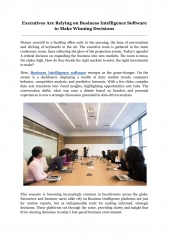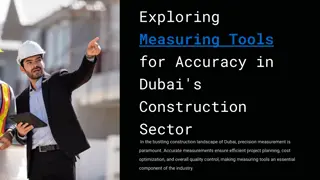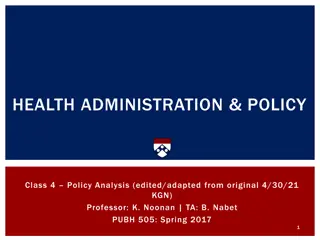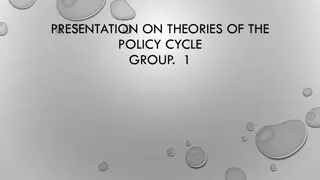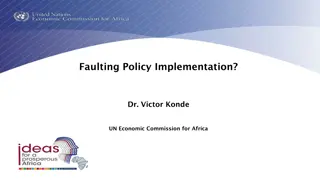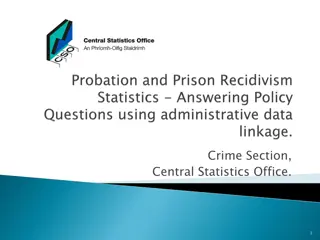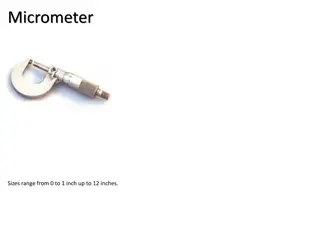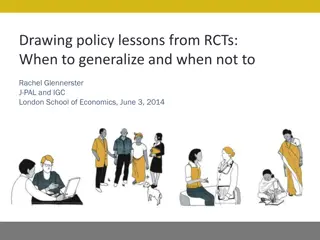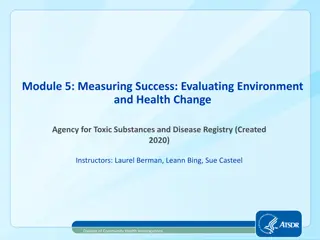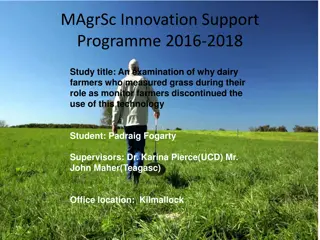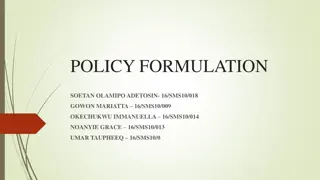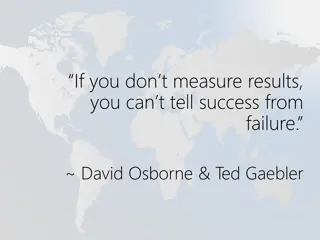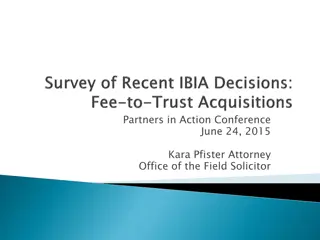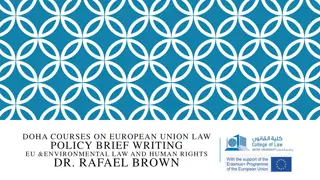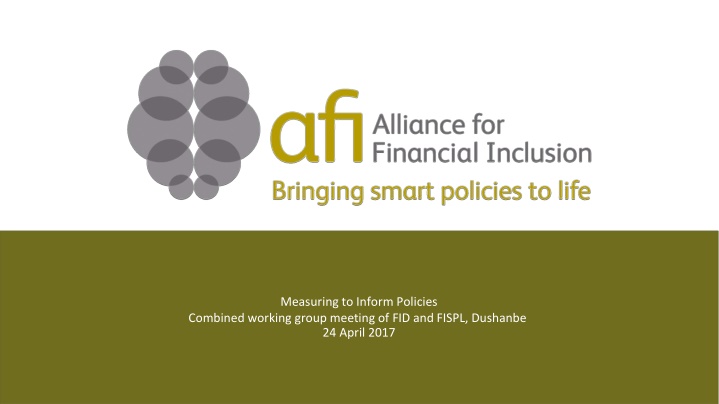
Measuring for Informed Policy Decisions
This content revolves around a combined working group meeting discussing measurement challenges in financial inclusion, the i2i approach, evidence-based policies, market analysis, client-centric product design, and data-driven decision-making to inform regulatory frameworks and policy development.
Download Presentation

Please find below an Image/Link to download the presentation.
The content on the website is provided AS IS for your information and personal use only. It may not be sold, licensed, or shared on other websites without obtaining consent from the author. If you encounter any issues during the download, it is possible that the publisher has removed the file from their server.
You are allowed to download the files provided on this website for personal or commercial use, subject to the condition that they are used lawfully. All files are the property of their respective owners.
The content on the website is provided AS IS for your information and personal use only. It may not be sold, licensed, or shared on other websites without obtaining consent from the author.
E N D
Presentation Transcript
Measuring to Inform Policies Combined working group meeting of FID and FISPL, Dushanbe 24 April 2017
Overview Who are we Our measurement work Measurement challenge in financial inclusion The i2i approach The way forward Bringing smart policies to life
Overview Who are we Our measurement work Measurement challenge in financial inclusion The i2i approach The way forward Bringing smart policies to life
Our measurement objective Are there areas of risk that requires regulatory attention? What is the state of financial inclusion? What is the state of financial inclusion? What are the areas of concern in financial inclusion? What is the structure of the market? Are people s lives improved by the use of financial services? Do regulations unnecessarily inhibit the use of financial services? What can be done to address those areas? Informed regulatory frameworks Evidence-based policies Policymakers Regulators Bringing smart policies to life
Our measurement objective What is the size of the market? Is there a business case? Are there market opportunities? Who are the current participants in the market? What are the user needs? How are these needs being met? Client-centric product design, lowered risk and cost Financial Service Providers Bringing smart policies to life
Inform policy through measurement What is the current state? Why are there deviations from the goal? Assessment What is the problem and what do I need to do? Evaluation Diagnostic Measure progress towards goal What indicators and what s an appropriate target? Target setting Monitoring Bringing smart policies to life
How we are addressing this? Catalysing innovation and change Development and testing Enabling greater insight Data driven decisions Bringing smart policies to life
Timeline: How we moved forward in financial inclusion measurement Financial inclusion adopted by G20 G20 Basic set of indicators adopted UFA 2020 launched AFI Core indicators adopted Maya + 700 million new bank accounts Declaration launched Bringing smart policies to life
Origins: Available data drove targets in financial inclusion G20 Basic Set Financial Inclusion Indicators Existing global / multi- country source AFI Core Indicators Number of access points per 10 000 adults Number of branches per 100 000 adults IMF FAS Access % of adults with at least one type of regulated deposit account % of adults with at least one type of regulated credit account % of adults with an account at a formal financial institution % of adults with at least one loan outstanding from a regulated financial institution Global Findex Usage Sources: G20 Financial Inclusion Indicators, AFI Core Indicators Bringing smart policies to life
New data collected allow us to develop indicators National Demand Side Surveys Bringing smart policies to life
Overview Who are we Our measurement work Measurement challenge in financial inclusion The i2i approach The way forward Bringing smart policies to life
What do we want to measure in financial inclusion? Enabling environment Access Uptake Usage Outcome Impact The utilization of a financial service Environment allows appropriate products to be provided Appropriate products are available to capable consumers to use An existing relationship with an FSP that confers the right to use a financial services without any further requirements having to be met Financial outcomes directly attributable to usage of financial services Household and government objectives for which the use of financial services is a necessary but not sufficient condition. Bringing smart policies to life
Usage theory Three assumptions: 1. Usage is necessary for financial inclusion outcomes and impact 2. Consumers choose financial services based on their underlying needs 3. Users engage different financial devices (payments, savings, credit, insurance), from different types of formal and informal providers, in meeting a specific need Bringing smart policies to life
Assumption 1: Usage is necessary for financial inclusion outcomes and impact (Transactional account example) Dormant account at FI (0 transactions) Used account at FI (> 3 transactions) Mailbox account at FI (1 - 2 transactions) 100% % of adults with an account at a 90% formal financial institution 80% 70% 60% 50% 40% 30% 20% 10% 0% Source: Findex 2014 Bringing smart policies to life
Assumption 2: Consumers choose financial services based on their underlying needs & Assumption 3: Users engage different devices to meet a need Use savings Borrow Use payment devices Use insurance Use multiple financial devices 100% 80% % of adult population 60% 40% 20% 0% Local payment Bill payment RDTV RCTV Liquidity Resilience Farming inputs Asset Education Investment in Business accumulation Meeting goals Transfer of value Source: FinScope Consumer Survey Zimbabwe 2014 Bringing smart policies to life
Understanding usage Switch to alternative device or revert to prior default (e.g. cash) Switch to an alternative For some devices: two-step progression: uptake as interim step After some time, value breaks down, prompting a switch First use/ trial Sustained use Positive (perceived) relative value Use case Ongoing use of the device over time Uptake For some devices, one-step progression: uptake and first use happen together Unmet need or use case falls away After some time, use case falls away or client does not meet need, and usage ceases Uptake or first use drivers Usage drivers Bringing smart policies to life
Unpacking the usage journey - 1 Supply Side Drivers Advertising Promotions Trials Increased access Demand Side Drivers Circumstantial Procrastination Paying for my children s school Bringing smart policies to life
Unpacking the usage journey - 2 Over-the-counter payments Paying for my children s school Bringing smart policies to life
Unpacking the usage journey - 3 Net Perceived Value Non-Functional Drivers Functional Drivers Behavioural factors Contextual factors Trust Meeting Needs Costs Bringing smart policies to life
Measuring usage Frequency Use case 1 Financial Device 1 Recency Financial Device 2 Use case 2 Financial Need Monetary value Financial Need: A human need that can be met by or through financial devices. Liquidity Resilience Meeting goals Transfer of value Financial Device 3 Use case 3 Duration Financial Device: A physical, social or electronic mechanism that stores, accumulates, distributes or transfers monetary value, and can be used to meet a financial need. Usage: A person deploying a financial device to meet a specific financial need. Use Case: Discrete purpose for which a person use a financial device. Bringing smart policies to life
Overview Who are we Our measurement work Measurement challenge in financial inclusion The i2i approach The way forward Bringing smart policies to life
The way forward Structuring the demand-side survey needs-based approach and usage metrics: South African survey just completed Needs strand for resilience Develop analytical framework for drivers of usage Will reflect individual country realities Match actual service provider data (supply-side) with survey data Determine drivers for uptake/first use Determine drivers for continued use/no use Consider other factors trust, financial capability, behavioural factors Develop outcome measurement framework Liquidity, resilience, meeting goals Validate consistency of measuring outcomes from usage and any other factors Bringing smart policies to life
The way forward Develop measurement lenses for Policy makers Regulators (Classes of financial service providers) Based on outcomes measurement framework Include additional data regulatory data, data on financial infrastructure, relevant non-financial data Work with specific countries to develop and test these lenses then extract insights for global approach Bringing smart policies to life
Inform policy through measurement What is the current state? Why are there deviations from the goal? Assessment What is the problem and what do I need to do? Evaluation Diagnostic Measure progress towards goal What indicators and what s an appropriate target? Target setting Monitoring Bringing smart policies to life
Inform policy through measurement THANK YOU! Bringing smart policies to life

